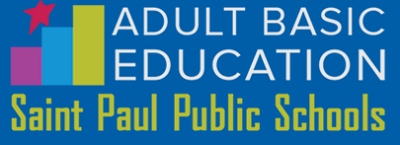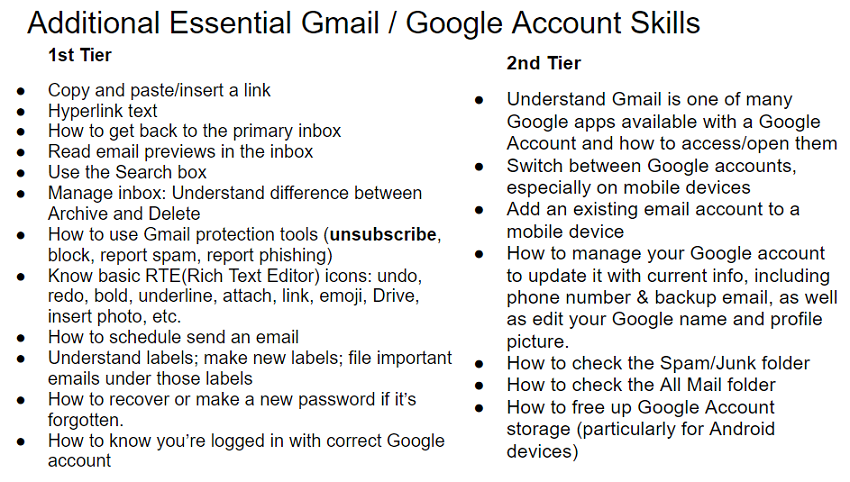- MN ABE Connect
- Archive
- Teaching Essential Email Skills and Digital Resilience
 November 27, 2023
November 27, 2023
Teaching Essential Email Skills and Digital Resilience
Adam Kieffer, InstructorWe all agree that it’s essential for adult learners to know the basics of how to send, read, and receive emails, but there are some other overlooked, yet essential email skills we could also be teaching. These include the following how-tos:
- Manage the inbox
- Search archived emails
- Unsubscribe from unwanted emails
- Scan for spam/phishing signs
- Delete vs. archive
- Use tools that are transferable to other email platforms
It also includes building learners’ digital resilience and self-efficacy in digital spaces.
Essential Gmail skills
![]() In my class, Everyday Digital Literacy, I require all my students to have and use Gmail because it’s the most used email platform in the world, and we (St. Paul ABE) use Google Classroom and Google Meet for our LMS and online meeting platform, respectively. Google accounts also work as a login on thousands of popular and educational sites, such as Typing.com and Khan Academy, and it’s fully integrated with Chrome, the most used browser in the U.S.
In my class, Everyday Digital Literacy, I require all my students to have and use Gmail because it’s the most used email platform in the world, and we (St. Paul ABE) use Google Classroom and Google Meet for our LMS and online meeting platform, respectively. Google accounts also work as a login on thousands of popular and educational sites, such as Typing.com and Khan Academy, and it’s fully integrated with Chrome, the most used browser in the U.S.
The Northstar Standards – one of the 3 sets of content standards adopted by MN Adult Education – define the basic skills needed to perform tasks on computers and online. Northstar’s standards for using email are an excellent place to start with any email instruction. However, from direct experience with learners who have developing digital learning skills and often low digital resilience, I’ve found that there are other essential skills that are not on Northstar’s list. I’ve included them here:
What is digital resilience?
In addition to teaching these Gmail skills, many of which are transferable to other email platforms, I’ve developed some tips or best practices for teaching these skills while simultaneously working to improve learners’ digital resilience, which I’ll share below. But first, a brief pause to help define and contextualize digital resilience.
Digital US defines digital resilience as “having the awareness, skills, agility, and confidence to be empowered users of new technologies and adapt to changing digital skill demands. Digital resilience improves the capacity to problem-solve and upskill, navigate digital transformations, and be active participants in society and the economy.”
(Source: https://digitalus.org/our-work/)
 Digital resilience means you have the ability to confidently navigate rapid digital transformation and become a lifelong learner of new digital technologies. A digitally resilient individual can choose and apply relevant skills in both familiar and unfamiliar contexts and recognize when a new skill is required. When faced with an unfamiliar context or required skill, instead of saying “I can’t do this,” a digitally resilient person will say, “I can’t do this yet, but I can figure it out (Building a Digitally Resilient Workforce: Creating On-Ramps to Opportunity, p. 6).”
Digital resilience means you have the ability to confidently navigate rapid digital transformation and become a lifelong learner of new digital technologies. A digitally resilient individual can choose and apply relevant skills in both familiar and unfamiliar contexts and recognize when a new skill is required. When faced with an unfamiliar context or required skill, instead of saying “I can’t do this,” a digitally resilient person will say, “I can’t do this yet, but I can figure it out (Building a Digitally Resilient Workforce: Creating On-Ramps to Opportunity, p. 6).”
In recent years, the focus in adult education has shifted from distance education to digital learning, or learning experiences that utilize digital tools. In addition to organically integrating tacit digital literacy skills into all ABE instruction by providing rich digital learning activities and environments, we should also be focusing on building our learners’ confidence and persistence, their digital resilience, while working and learning in those spaces.
OTAN’s Digital Learning Guidance offers these words and definitions:
Digital learning can happen in any learning environment—whether online, in-person, or blended—but requires adult learners to develop digital literacy and exhibit digital resilience. This is an umbrella term that entails so much of how education is delivered and learning is done now. The benefits of digital learning for students include added convenience and flexibility, increased self-confidence, and development of academic and digital literacy skills. For educators, the benefits of digital learning include the ability to differentiate instruction, facilitate personalized learning, monitor learner progress, and provide feedback.
Digital literacy includes the ability to find, evaluate, organize, create, and communicate digital information.
Digital resilience signifies having the awareness, skills, agility, and confidence to be empowered users of new technologies and adapt to changing digital skill demands.
(Source: California Adult Education Digital Learning Guidance, p. 12-13)
Building digital resilience
Now, back to some best phrases and practices to use while digital learning is happening. What learners often need to learn, regardless of the content, in order for them to build their digital resilience, is to let go of the fear of making mistakes as well as the fear of breaking something. So these are some tactics and phrases I repeatedly use in my classrooms to help them on that path.
- Show; don’t tell. (Demonstrate, screencasts, screenshots, gifs)
- Chunk content and skills. (KISS – “Keep it small, Smartypants.”)
- “Slow down; do it again. You can do it.”
- “Let’s take a couple deep breaths and do it again.”
- “Making mistakes is how we learn everything.”
- Learn from your mistakes by doing it better, faster, easier, more fluidly next time.
- “It’s ok; You can’t break it!”
- (Even if you delete it, you can undo or recover.)
- “Show me.” … – What you know/What you can do/What’s happening
- “What do you think…?” – What do you think you should do/click/open/search for next?
- Take the time to teach specific vocabulary or phrases, whether they’re L1 of ELLs.
- Be explicit in making the connection between language/vocab, technology tools, features, and skills.
- For example, the Settings icon: always called Settings; always a gear shape; always a go-to place to make changes; and so on. This is a transferable word, icon, skill, etc.
Additional resources
I have lots more to say on this topic, but limited space. So, for now, here’s one set of slides that I have used to teach some essential email skills, as well as this corresponding quiz. In addition, here’s a recording of a short session that I did on this topic from April, 2023.

Newsletter Signup
Get MN ABE Connect—the official source for ABE events, activities, and resources!
Sign UpArticle Categories
- ABE Foundations/Staff Onboarding
- ACES/Transitions
- Adult Career Pathways
- Assessment
- CCR Standards
- Citizenship
- COVID-19
- Cultural Competency
- Digital Literacy/Northstar
- Disabilities
- Distance Learning/Education
- ELA
- Equity/Inclusion
- ESL
- HSE/Adult Diploma
- Listening
- Math/Numeracy
- Mental Health
- Minnesota ABE
- One-Room Schoolhouse/Multilevel
- Professional Development
- Program Management
- Reading
- Remote Instruction
- Science
- Social Studies
- Speaking/Conversation
- Support Services
- Teaching Strategies
- Technology
- Uncategorized
- Volunteers/Tutors
- Writing
